Space Shuttle Mission Chronology: Part 4 – 1981-1988
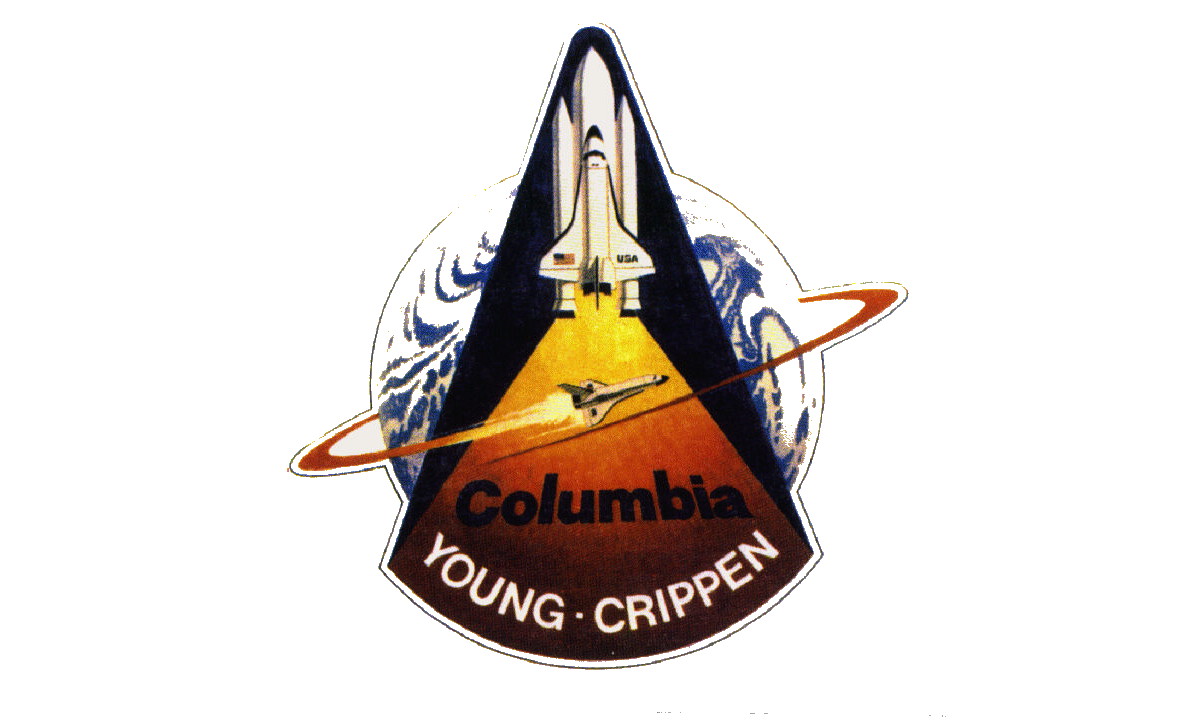
Continued from:
Space Shuttle Mission Chronology: Part 1 — 1999-2011
Space Shuttle Mission Chronology: Part 2 — 1995-1998
Space Shuttle Mission Chronology: Part 3 — 1989-1994
1988
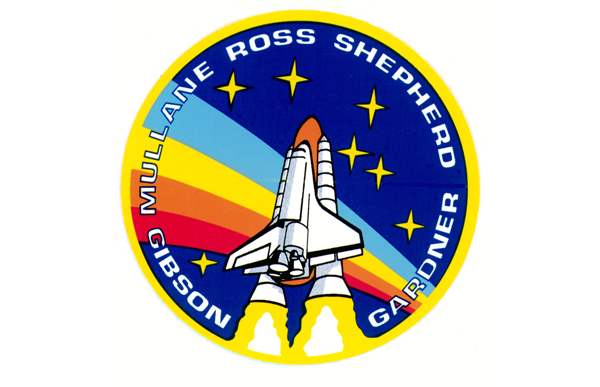
STS-27
Mission: Department of Defense
Space Shuttle: Atlantis
Launch Pad: 39B
Launched: Dec. 2, 1988, 9:30:34 a.m. EST
Landing Site: Edwards Air Force Base, Calif.
Landing: Dec. 6, 1988, 3:36:11 p.m. PST
Mission Duration: 4 days, 9 hours, 5 minutes, 37 seconds
Orbit Altitude: Classified
Orbit Inclination: 57 degrees
Third mission dedicated to the Department of Defense.
Get the Space.com Newsletter
Breaking space news, the latest updates on rocket launches, skywatching events and more!
Commander Robert L. Gibson, Pilot Guy S. Gardner, Mission Specialists Richard Mullane, Jerry L. Ross and William M. Shepherd .
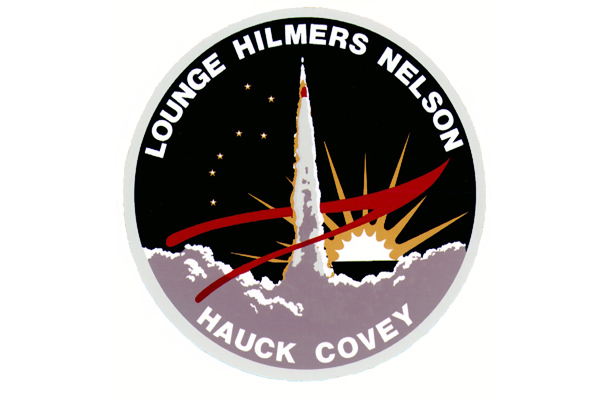
STS-26: Return to Flight
Mission: TDRS-C
Space Shuttle: Discovery
Launch Pad: 39B
Launched: Sept. 29, 1988, 11:37:00 a.m. EDT
Landing Site: Edwards Air Force Base, Calif.
Landing: October 3, 1988, 9:37:11 a.m. PDT
Mission Duration: 4 days, 1 hour, 0 minutes, 11 seconds
Orbit Altitude: 203 nautical miles
Orbit Inclination: 28.5 degrees
The primary payload, NASA Tracking and Data Relay Satellite-3 (TDRS-3) attached to an Inertial Upper Stage (IUS), became the second TDRS deployed. After deployment, IUS propelled the satellite to a geosynchronous orbit. Secondary payloads: Physical Vapor Transport of Organic Solids (PVTOS); Protein Crystal Growth (PCG); Infrared Communications Flight Experiment (IRCFE); Aggregation of Red Blood Cells (ARC); Isoelectric Focusing Experiment (IFE); Mesoscale Lightning Experiment (MLE); Phase Partitioning Experiment (PPE); Earth-Limb Radiance Experiment (ELRAD); Automated Directional Solidification Furnace (ADSF) and two Shuttle Student Involvement Program (SSIP) experiments. Orbiter Experiments Autonomous Supporting Instrumentation System-I (OASIS-I) recorded variety of environmental measurements during various inflight phases of orbiter.
Ku-band antenna in the payload bay was deployed; however, the dish antenna command and actual telemetry did not correspond. Also, the orbiter cabin Flash Evaporator Sy
Crew consisted of Commander Frederick H. Hauck, Pilot Richard O. Covey, Mission Specialists John M. Lounge, George D. Nelson and David C. Hilmers
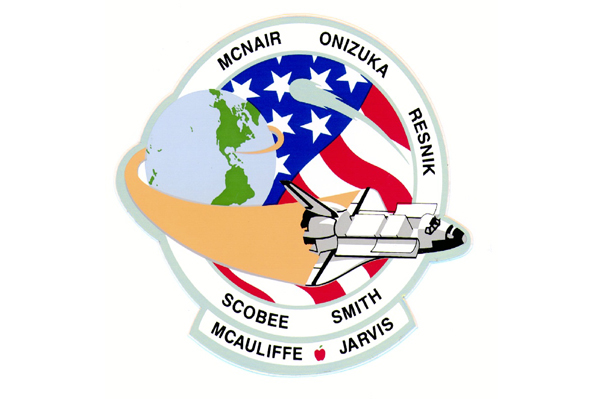
STS-51L
Mission: TDRS-2; SPARTAN-203 Satellites
Space Shuttle: Challenger
Launch Pad: 39B
Launched: Jan. 28, 1986, 11:38:00 a.m. EST
Mission Duration: 1 minute, 13 seconds
Orbit Altitude: 150 nautical miles (planned)
Orbit Inclination: 28.5 degrees (planned)
An explosion 73 seconds after liftoff claimed crew and vehicle. The cause of explosion was determined to be an o-ring failure in the right solid rocket booster. Cold weather was determined to be a contributing factor.
Crew consisted of Commander Francis R. Scobee, Pilot Michael J. Smith, Mission Specialists Judith A. Resnik, Ellison S. Onizuka, Ronald E. McNair and Payload Specialists Gregory B. Jarvis and Sharon Christa McAuliffe.
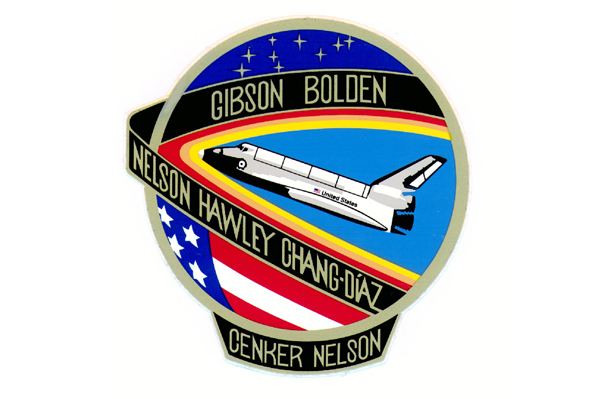
STS-61C
Mission: SATCOM KU-1
Space Shuttle: Columbia
Launch Pad: 39A
Launched: January 12, 1986, 6:55:00 a.m. EST
Landing Site: Edwards Air Force Base, Calif.
Landing: January 18, 1986, 5:58:51 a.m. PST
Mission Duration: 6 days, 2 hours, 3 minutes, 51 seconds
Orbit Altitude: 212 nautical miles
Orbit Inclination: 28.5 degrees
The SATCOM KU-I (RCA Americom) satellite, attached to the Payload Assist Module-D2 (PAM-D2) motor, was deployed. Comet Halley Active Monitoring Program (CHAMP) experiment, a 35mm camera to photograph Comet Halley, did not function properly due to battery problems. Other payloads: Materials Science Laboratory-2 (MSL-2); Hitchhiker G-1; Infrared Imaging Experiment (IR-IE); Initial Blood Storage Experiment (IBSE); Hand-held Protein Crystal Growth (HPCG) experiment; three Shuttle Student Involvement Program (SSIP) experiments and 13 Get Away Specials (GAS), 12 of them mounted on a special GAS Bridge Assembly.
Crew consisted of Commander Robert L. Gibson, Pilot Charles F. Bolden, Jr., Mission Specialists Franklin R. Chang-Diaz, Steven A. Hawley, George D. Nelson and Payload Specialists Robert J. Cenker and Congressman Bill Nelson.
1985
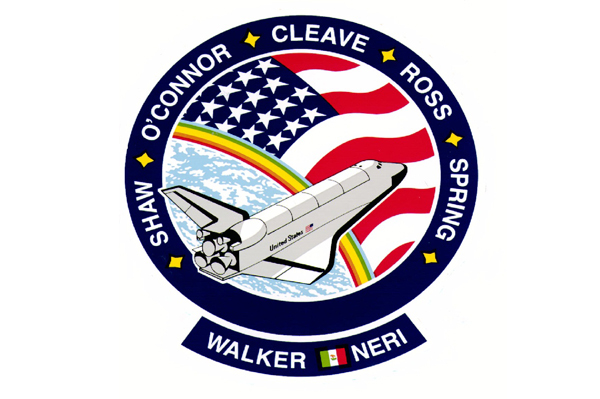
STS-61B
Mission: MORELOS-B; AUSSAT-2; SATCOM KU-2
Space Shuttle: Atlantis
Launch Pad: 39A
Launched: November 26, 1985, 7:29:00 p.m. EST
Landing Site: Edwards Air Force Base, Calif.
Landing: December 3, 1985, 1:33:49 p.m. PST
Mission Duration: 6 days, 21 hours, 4 minutes, 49 seconds
Orbit Altitude: 225 nautical miles
Orbit Inclination: 57 degrees
Three communications satellites were deployed: MORE LOS-B (Mexico), AUSSAT-2 (Australia) and SATCOM KU-2 (RCA Americom). MORELOS-B and AUSSAT-2 were attached to the Payload Assist Module-D motors, SATCOM KU-2 to a PAM-D2 designed for heavier payloads. Two experiments were conducted to test assembling erectable structures in space: Experimental Assembly of Structures in Extravehicular Activity (EASE) and Assembly Concept for Construction of Erectable Space Structure (ACCESS). The experiments required two space walks by Spring and Ross lasting five hours, 32 minutes, and six hours, 38 minutes, respectively. Middeck payloads: Continuous Flow Electrophoresis System (CFES); Diffusive Mixing of Organic Solutions (DMOS); Morelos Payload Specialist Experiments (MPSE) and Orbiter Experiments (OEX). In payload bay: Get Away Special and IMAX Cargo Bay Camera (ICBC).
Crew consisted of Commander Brewster H. Shaw, Jr., Pilot Bryan D. O'Connor, Mission Specialists Mary L. Cleave, Sherwood C. Spring, Jerry L. Ross and Payload Specialists Rodolfo Neri Vela and Charles D. Walker.
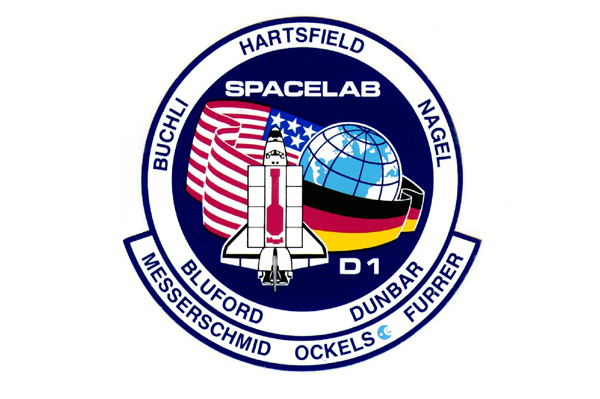
STS-61A
Mission:D-1 Spacelab Mission (First German Dedicated Spacelab)
Space Shuttle: Challenger
Launch Pad: 39A
Launched: October 30, 1985, 12:00:00 p.m. EST
Landing Site: Edwards Air Force Base, Calif.
Landing: November 6, 1985, 9:44:53 a.m. PST
Mission Duration: 7 days, 0 hours, 44 minutes, 51 seconds
Orbit Altitude: 207 nautical miles
Orbit Inclination: 57 degrees
The dedicated German Spacelab (D-1) mission was conducted in a long module configuration, which featured a Vestibular Sled designed to give scientists data on the functional organization of human vestibular and orientation systems. Spacelab D-1 encompassed 75 numbered experiments, most performed more than once. The mission included basic and applied microgravity research in fields of materials science, life sciences and technology, and communications and navigation. Though the orbiter was controlled from Johnson Space Center, scientific operations were controlled from the German Space Operations Center at Oberpfaffenhofen, near Munich. Other objectives: Global Low Orbiting Message Relay (GLOMR) satellite deployed from Get Away Special canister.
Crew consisted of Commander Henry W. Hartsfield, Jr., Pilot Steven R. Nagel, Mission Specialists James F. Buchli, Guion S. Bluford, Bonnie J. Dunbar and Payload Specialists Reinhard Furrer, Ernst Messerschmid and Wubbo J. Ockels.
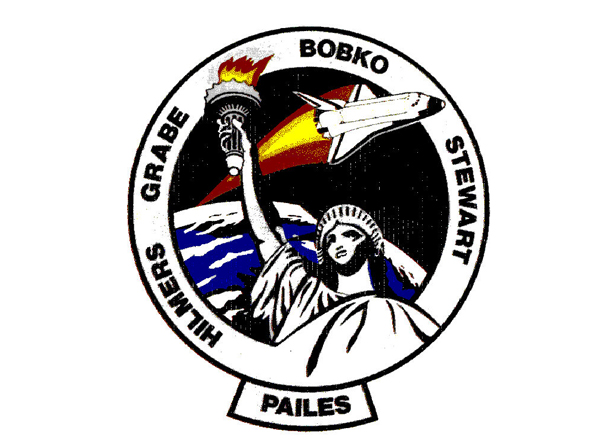
STS-51J
Mission: Department of Defense
Space Shuttle: Atlantis
Launch Pad: 39A
Launched: Oct. 3, 1985 at 11:15:30 a.m. EDT
Landing Site: Edwards Air Force Base, Calif.
Landing: Oct. 7, 1985 at 10:00:08 a.m. PDT
Mission Duration: 4 days, 1 hour, 44 minutes, 38 seconds
Orbit Altitude: 319 nautical miles
Orbit Inclination: 28.5 degrees
The launch was delayed 22 minutes, 30 seconds due to a main engine liquid hydrogen prevalve close remote power controller showing a faulty 'on' indication. This was the second mission dedicated to the Department of Defense.
Crew consisted of Commander Karol J. Bobko, Pilot Ronald J. Grabe, Mission Specialists David C. Hilmers, Robert L. Stewart and William A. Pailes.
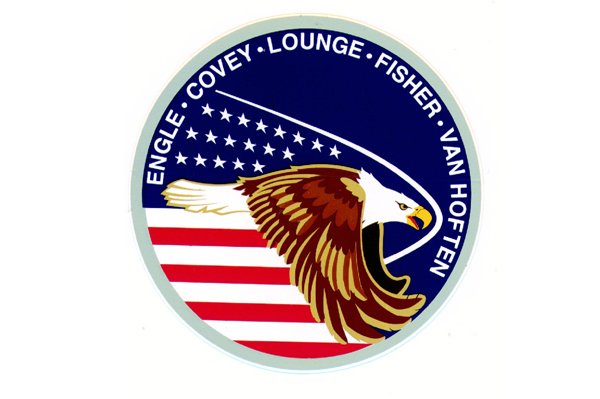
STS-51I
Mission:ASC-1/American Satellite Company, AUSSAT-1/Australian Communications Satellite, SYNCOM IV-4
Space Shuttle: Discovery
Launch Pad: 39A
Launched: Aug. 27, 1985 at 6:58:01 a.m. EDT
Landing Site: Edwards Air Force Base, Calif.
Landing: Sept. 3, 1985 at 6:15:43 a.m. PDT
Mission Duration: 7 days, 2 hours, 17 minutes, 42 seconds
Orbit Altitude: 242 nautical miles
Orbit Inclination: 28.45 degrees
Three communications satellites were deployed: ASC-1, for American Satellite Company; AUSSAT-1, an Australian Communications Satellite; and SYNCOM IV-4, the Synchronous Communications Satellite. ASC-1 and AUSSAT-1 both attached to Payload Assist Module-D (PAM-D) motors. SYNCOM IV-4 (also known as LEASAT-4) failed to function after reaching the correct geosynchronous orbit. Fisher and van Hoften performed two extravehicular activities (EVAs) totaling 11 hours, 51 minutes. Part of time spent retrieving, repairing and redeploying LEASAT-3, which had been deployed on Mission 51-D. Middeck Payload: Physical Vapor Transport Organic Solid Experiment (PVTOS).
Commander Joe H. Engle, Pilot Richard O. Covey, and Mission Specialists James D. A. van Hoften, John M. Lounge and William F. Fisher.
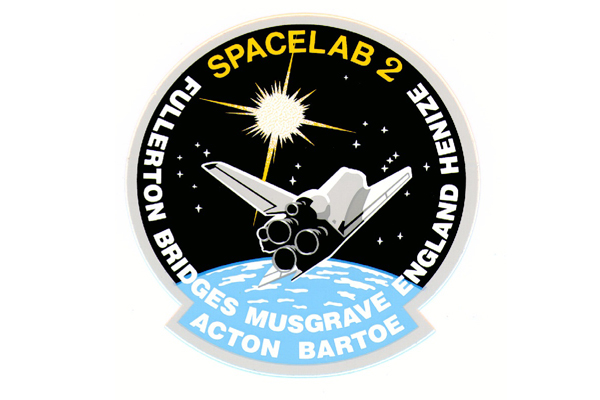
STS-51F
Mission: Spacelab-2
Space Shuttle: Challenger
Launch Pad: 39A
Launched: July 29, 1985 at 5:00:00 p.m. EDT
Landing Site: Edwards Air Force Base, Calif.
Landing: August 6, 1985 at 12:45:26 p.m. PDT
Mission Duration: 7 days, 22 hours, 45 minutes, 26 seconds
Orbit Altitude: 173 nautical miles
Orbit Inclination: 49.5 degrees
Primary payload was Spacelab-2. Despite abort-to-orbit, which required mission replanning, mission declared success. Special part of modular Spacelab system, the Igloo, located at head of three-pallet train, provided on-site support to instruments mounted on pallets. Main mission objective was to verify performance of Spacelab systems and determine interface capability of orbiter, and measure environment induced by spacecraft. Experiments covered life sciences, plasma physics, astronomy, high-energy astrophysics, solar physics, atmospheric physics and technology research.
Crew consisted of Commander Gordon Fullerton, Pilot Roy D. Bridges, Jr., Mission Specialists F. Story Musgrave, Anthony W. England, Karl G. Henize and Payload Specialists Loren W. Acton and John-David F. Bartoe.
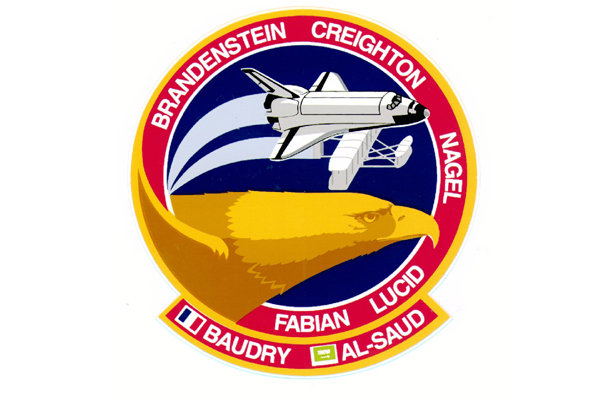
STS-51G
Mission: MORELOS-A, ARABSAT-A and TELSTAR-3D Communications Satellites
Space Shuttle: Discovery
Launch Pad: 39A
Launched: June 17, 1985 at 7:33:00 a.m. EDT
Landing Site: Edwards Air Force Base, Calif.
Landing: June 24, 1985 at 6:11:52 a.m. PDT
Mission Duration: 7 days, 1 hour, 38 minutes, 52 seconds
Orbit Altitude: 209 nautical miles
Orbit Inclination: 28.45 degrees
Three communications satellites, all attached to the Payload Assist Module-D (PAM-D) motors, were deployed: MORELOS-A, for Mexico; ARABSAT-A, for Arab Satellite Communications Organization; and TELSTAR-3D, for AT&T. Also flown: deployable/retrievable Shuttle Pointed Autonomous Research Tool for Astronomy (SPARTAN-1); six Get Away Special canisters; Strategic Defense Initiative experiment called the High Precision Tracking Experiment (HPTE); a materials processing furnace called Automated Directional Solidification Furnace (ADSF); and two French biomedical experiments.
Crew consisted of Commander Daniel C. Brandenstein, Pilot John O. Creighton, Mission Specialists Shannon W. Lucid, John M. Fabian, Steven R. Nagel and Payload Specialists Patrick Baudry and Sultan Salman Al-Saud.
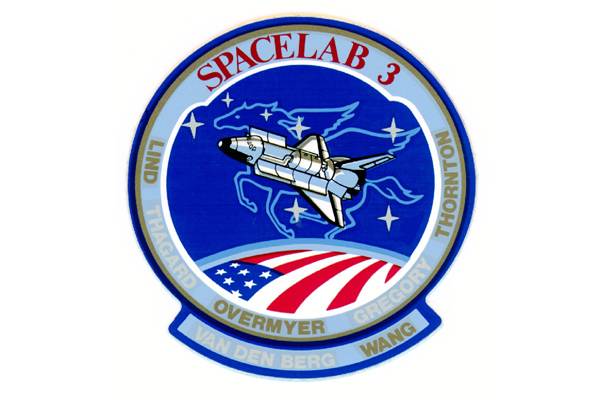
STS-51B
Mission:Spacelab-3
Space Shuttle: Challenger
Launch Pad: 39A
Launched: April 29, 1985 at 12:02:18 p.m. EDT
Landing Site: Edwards Air Force Base, Calif.
Landing: May 6, 1985 at 9:11:04 a.m. PDT
Mission Duration: 7 days, 0 hours, 8 minutes, 46 seconds
Orbit Altitude: 222 nautical miles
Orbit Inclination: 57 degrees
The primary payload was Spacelab-3. This was the first operational flight for the Spacelab orbital laboratory series developed by the European Space Agency. Spacelab includes five basic discipline areas: materials sciences, life sciences, fluid mechanics, atmospheric physics, and astronomy. The main mission objective with Spacelab-3 was to provide a high quality microgravity environment for delicate materials processing and fluid experiments. Two monkeys and 24 rodents were observed for the effects of weightlessness. Of the 15 Spacelab primary experiments conducted, 14 were considered successful. Two Get Away Specials were on board.
Crew consisted of Commander Robert F. Overmyer, Pilot Frederick D. Gregory, Mission Specialists Don L. Lind, Norman E. Thagard, William E. Thornton and Payload Specialists Lodewijk van den Berg and Taylor G. Wang.
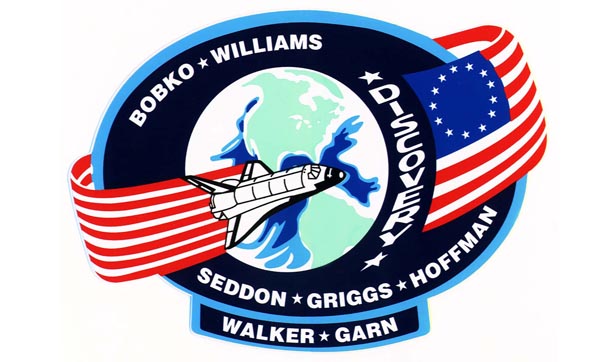
STS-51D
Mission: TELSAT-I, Communications Satellite SYNCOM IV-3
Space Shuttle: Discovery
Launch Pad: 39A
Launched: April 12, 1985 at 8:59:05 a.m. EST
Landing Site: Kennedy Space Center, Florida
Landing: April 19, 1985 at 8:54:28 a.m. EST
Mission Duration: 6 days, 23 hours, 55 minutes, 23 seconds
Orbit Altitude: 285 nautical miles
Orbit Inclination: 28.5 degrees
The TELESAT-l (ANIK C-1) communications satellite was deployed attached to the payload assist module (PAM-D) motor. SYNCOM IV-3 (also known as LEASAT-3) was also deployed but the spacecraft sequencer failed to initiate the antenna deployment, spin up and ignition of perigee kick motor. The mission was extended two days to make certain the sequencer start lever was in the proper position. Griggs and Hoffman performed a space walk to attach Flyswatter devices to the remote manipulator system. Seddon engaged LEASAT lever using the remote manipulator system but the post deployment sequence did not begin. Other payloads were: Continuous Flow Electrophoresis System (CFES) III, flying for sixth time; two Shuttle Student Involvement Program (SSIP) experiments; American Flight Echocardiograph (AFE); two Get Away Specials; Phase Partitioning Experiments (PPE); astronomy photography verification test; medical experiments and toys in space, an informal study of the behavior of simple toys in weightless environment, with results to be made available to school students.
Crew consisted of Commander Karol J. Bobko, Pilot Donald E. Williams, Mission Specialists M. Rhea Seddon, Jeffrey A. Hoffman, S. David Griggs and Payload Specialists Charles D. Walker and Sen. E. Jake Garn.
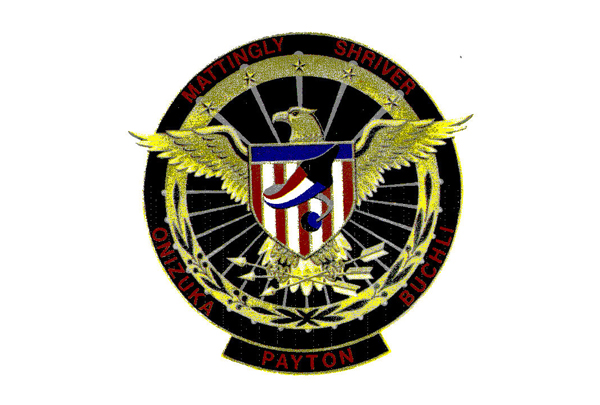
STS-51C
Mission: Department of Defense
Space Shuttle: Discovery
Launch Pad: 39A
Launched: January 24, 1985 at 2:50:00 p.m. EST
Landing Site: Kennedy Space Center, Florida
Landing: January 27, 1985 at 4:23:23 p.m. EST
Mission Duration: 3 days, 1 hour, 33 minutes, 23 seconds
Orbit Altitude: 220 nautical miles
Orbit Inclination: 28.5 degrees
This was the first mission dedicated to the Department of Defense. The U.S. Air Force Inertial Upper Stage (IUS) booster was deployed and met the mission objectives.
Crew consisted of Commander Thomas K. Mattingly, II, Pilot Loren J. Shriver, Mission Specialists Ellison S. Onizuka, James F. Buchli and Payload Specialist Gary E. Payton.
1984
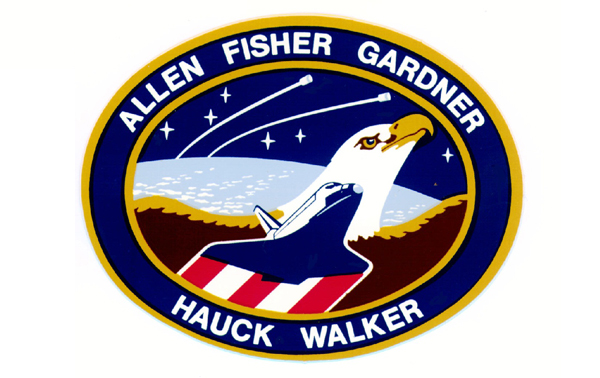
STS-51A
Mission: TELESAT-H, Canadian communications satellite, SYNCOM IV-1 defense communications satellite
Space Shuttle: Discovery
Launch Pad: 39A
Launched: November 8, 1984 at 7:15:00 a.m. EST
Landing Site: Kennedy Space Center, Florida
Landing: November 16, 1984 at 6:59:56 a.m. EST
Mission Duration: 7 days, 23 hours, 44 minutes, 56 seconds
Orbit Altitude: 185 nautical miles
Orbit Inclination: 28.5 degrees
The Canadian communications satellite TELESAT-H (ANIK), attached to Payload Assist Module-D (PAM-D) was deployed into geosynchronous orbit on flight day two. On the third day, the defense communications satellite SYNCOM IV-I (also known as LEASAT-1) was deployed. Allen and Gardner, wearing jet-propelled manned maneuvering units, retrieved two malfunctioning satellites: PALAPA-B2 and WESTAR-VI, both of these satellites were deployed on Mission 41-B. Fisher operated the remote manipulator system, grappling satellites and depositing them in the payload bay. Middeck payloads for this mission were: Diffusive Mixing of Organic Solutions (DMOS), and Radiation Monitoring Equipment (RME).
Crew consisted of Commander Frederick H. Hauck, Pilot David M. Walker, Mission Specialists Anna L. Fisher, Dale A. Gardner and Joseph P. Allen.
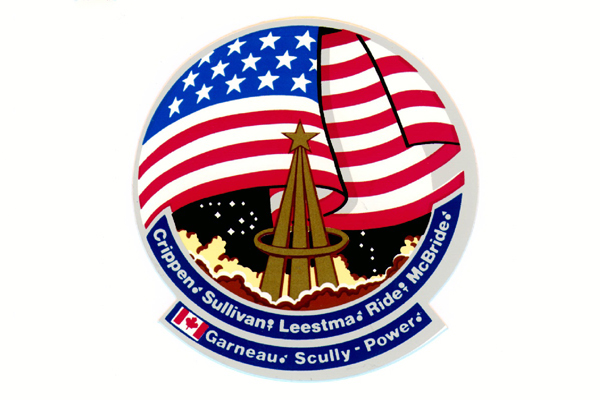
STS-41G
Mission: Earth Radiation Budget Satellite, Office of Space and Terrestrial Applications-3
Space Shuttle: Challenger
Launch Pad: 39A
Launched: October 5, 1984 at 7:03:00 a.m. EDT
Landing Site: Kennedy Space Center, Florida
Landing: October 13, 1984 at 12:26:38 p.m. EDT
Mission Duration: 8 days, 5 hours, 23 minutes, 38 seconds
Orbit Altitude: 218 nautical miles
Orbit Inclination: 57 degrees
This was the first flight to include two women, Ride and Sullivan. Sullivan was the first American woman to walk in space. The Earth Radiation Budget Satellite (ERBS) was deployed less than nine hours into the flight. The Office of Space and Terrestrial Applications-3 (OSTA-3) carried three experiments in the payload bay. Components of Orbital Refueling System (ORS) were connected, demonstrating it is possible to refuel satellites in orbit. Other Payloads were: Large Format Camera (LFC); IMAX Camera, flying for the third time; a package of Canadian Experiments (CANEX); Auroral Photography Experiment (APE); Radiation Monitoring Equipment (RME); Thermoluminiscent Dosimeter (TLD); and eight Get Away Specials.
Crew consisted of Commander Robert L. Crippen, Pilot Jon A. McBride, Mission Specialists Kathryn D. Sullivan, Sally K. Ride, David C. Leestma and Payload Specialists Marc Garneau and Paul D. Scully-Power.
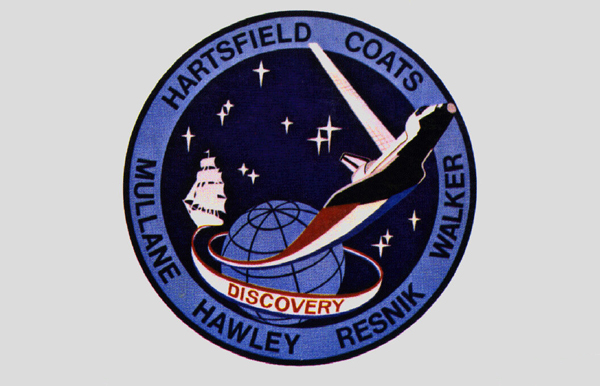
STS-41D
Mission: SBS-D; Satellite Business System SYNCOM IV-2; Solar Wing TELSTAR
Space Shuttle: Discovery
Launch Pad: 39A
Launched: August 30, 1984 at 8:41:50 a.m. EDT
Landing Site: Edwards Air Force Base, Calif.
Landing: September 5, 1984 at 6:37:54 a.m. PDT
Mission Duration: 6 days, 0 hours, 56 minutes, 4 seconds
Orbit Altitude: 184 nautical miles
Orbit Inclination: 28.5 degrees
Three satellites deployed during this mission: Satellite Business System SBS-D, SYNCOM IV-2 (also known as LEASAT2) and TELSTAR. The 102-foot-tall, 13-foot-wide Office of Application and Space Technology (OAST-1) solar wing extended from the payload bay. The wing carried different types of solar cells and extended to its full height several times. It demonstrated large lightweight solar arrays for a future in building large facilities in space such as a space station. Other payloads included were: Continuous Flow Electrophoresis System (CFES) Ill; Radiation Monitoring Equipment (RME); Shuttle Student Involvement Program (SSIP) experiment; lMAX camera, being flown for a second time; and an Air Force experiment, Cloud Logic to Optimize Use of Defense Systems (CLOUDS).
Crew consisted of Commander Henry W. Hartsfield, Jr., Pilot Michael L. Coats, Mission Specialists Judith A. Resnick, Steven A. Hawley, Richard M. Mullane and Payload Specialist Charles D. Walker.
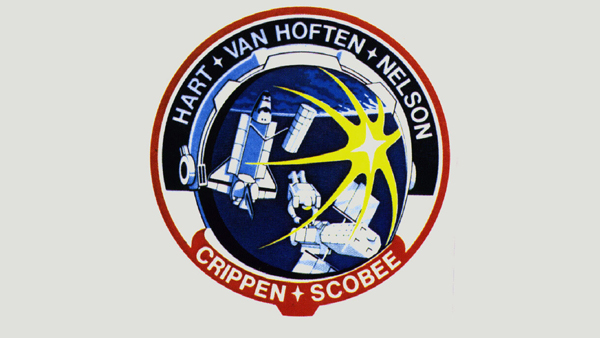
STS-41C
Mission: Long Duration Exposure Facility deploy, first on-orbit spacecraft repair
Space Shuttle: Challenger
Launch Pad: 39A
Launched: April 6, 1984 at 8:58:00 a.m. EST
Landing Site: Edwards Air Force Base, Calif.
Landing: April 13, 1984 at 5:38:07 a.m. PST
Mission Duration: 6 days, 23 hours, 40 minutes, 7 seconds
Orbit Altitude: 313 nautical miles
Orbit Inclination: 28.5 degrees
The first direct ascent trajectory for space shuttle. Using the manned maneuvering unit, astronauts replaced the altitude control system and coronagraph/polarimeter electronics box in the Solar Max satellite while it remained in orbit. The Long Duration Exposure Facility (LDEF) was deployed, carrying 57 experiments which were left on orbit with an intention of retrieving them during a later mission. Other payloads on this mission were: IMAX camera; Radiation Monitoring Equipment (RME); Cinema 360; Shuttle Student Involvement Program (SSlP) experiment.
Crew consisted of Commander Robert L. Crippen, Pilot Francis R. Scobee, Mission Specialists Geroge D. Nelson, James D. A. Van Hoften and Terry J. Hart.
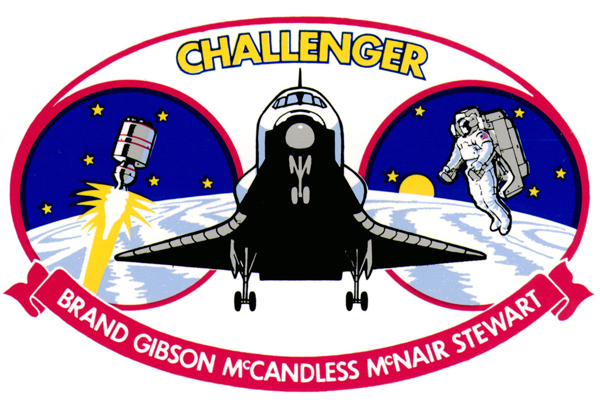
STS-41B
Mission: WESTAR-VI, Manned Maneuvering Unit, PALAPA-B2, First KSC Landing
Space Shuttle: Challenger
Launch Pad: 39A
Launched: February 3, 1984 at 8:00:00 a.m. EST
Landing Site: Kennedy Space Center, Florida
Landing: February 11, 1984 at 7:15:55 a.m. EST
Mission Duration: 7 days, 23 hours, 15 minutes, 55 seconds
Orbit Altitude: 189 nautical miles
Orbit Inclination: 28.5 degrees
On this mission the first untethered space walks were carried out by McCandless and Stewart, using the manned maneuvering unit. The WESTAR-VI and PALAPA-B2 satellites were deployed, but failure of the Payload Assist Module-D (PAM-D) rocket motors left them in radical low-Earth orbits. The German-built Shuttle Pallet Satellite (SPAS), originally flown on STS-7, became the first satellite refurbished and carried back into space. SPAS remained in the payload bay due to an electrical problem with Remote Manipulator System (RMS). The RMS manipulator foot restraints were first used to practice procedures performed for Solar Maximum satellite retrieval and repair planned for next mission. Integrated Rendezvous Target (IRT) failed due to an internal issue. Five Get Away Special canisters flown in the cargo bay and Cinema-360 camera were used by crew. Other payloads included: Acoustic Containerless Experiment System (ACES); Monodisperse Latex Reactor (MLR); Radiation Monitoring Equipment (RME), and Isoelectric Focusing (IEF) payload.
Crew consisted of Commander Vance D. Brand, Pilot Robert L. Gibson, Mission Specialists Bruce McCandless II, Ronald E. McNair and Robert L. Stewart.
1983
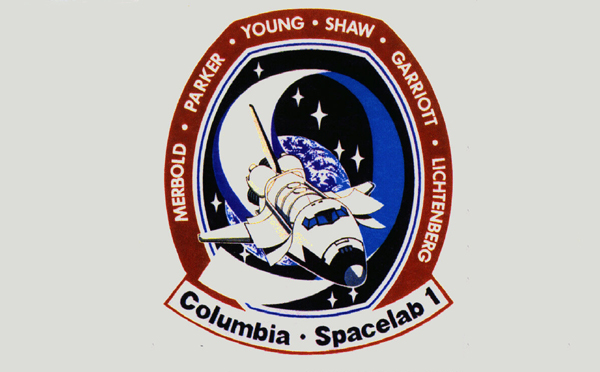
STS-9
Mission: Orbital Laboratory and Observations Platform/First Spacelab Mission
First Rollback/First 6 Crew Member Flight
Space Shuttle: Columbia
Launch Pad: 39A
Launched: November 28, 1983 at 11:00:00 a.m. EST
Landing Site: Edwards Air Force Base, Calif.
Landing: December 8, 1983 at 3:47:24 a.m. PST
Mission Duration: 10 days, 7 hours, 47 minutes and 24 seconds
Orbit Altitude: 155 nautical miles
Orbit Inclination: 57 degrees
This flight carried first Spacelab mission and first astronaut to represent the European Space Agency (ESA), Ulf Merbold of Germany. ESA and NASA jointly sponsored the Spacelab-1 and conducted investigations which demonstrated the capability for advanced research in space. Spacelab is an orbital laboratory and contains an observations platform composed of cylindrical pressurized modules and U-shaped unpressurized pallets which remain in the orbiter's cargo bay during flight. Altogether 73 separate investigations were carried out in astronomy and physics, atmospheric physics, Earth observations, life sciences, materials sciences, space plasma physics and technology. This was the first time six persons were carried into space on a single vehicle.
Crew consisted of Commander John W. Young, Pilot Brewster H. Shaw Jr., Mission Specialists Owen K. Garriott, Robert A. R. Parker and Payload Specialists Byron K. Lichtenberg and Ulf Merbold of the European Space Agency.
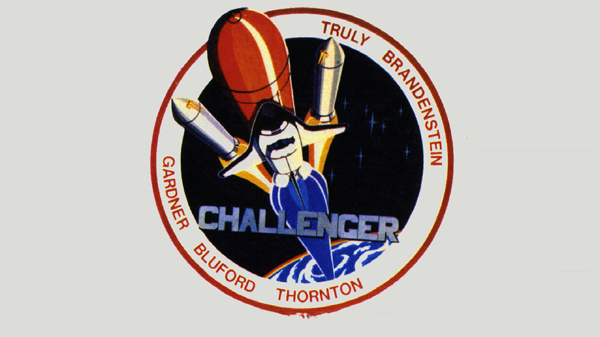
STS-8
Mission: Multipurpose Satellite/First Night Launch and Landing
Space Shuttle: Challenger
Launch Pad: 39A
Launched: Aug. 30, 1983 at 2:32:00 a.m. EDT
Landing Site: Edwards Air Force Base, Calif.
Landing: Sept. 5, 1983 at 12:40:43 a.m. PDT
Mission Duration: 6 days, 1 hour, 8 minutes and 43 seconds
Orbit Altitude: 191 nautical miles
Orbit Inclination: 28.5 degrees
Bluford became the first African-American to fly in space. INSAT-1B, a multipurpose satellite for India which was attached to the Payload Assist Module-D (PAM-D) motor, was deployed. The nose of orbiter was held away from the sun for 14 hours to test the flight deck area in extreme cold. For the Development Flight Instrumentation Pallet (DFI PLT), the crew filmed performance of an experimental heat pipe mounted in the cargo bay; also, the orbiter dropped to 139 miles altitude to perform tests on thin atomic oxygen to identify the cause of glow that surrounds parts of the orbiter at night. The remote manipulator system was tested to evaluate joint reactions to higher loads. The following biofeedback experiment was conducted: six rats were flown in the Animal Enclosure Module to observe animal reactions in space. Other payloads on this mission: Continuous Flow Electrophoresis System (CFES); Shuttle Student Involvement Program (SSlP) experiment; Incubator-Cell Attachment Test (l CAT); Investigation of STS Atmospheric Luminosities (ISAL); Radiation Monitoring Equipment (RME); and five Get Away Special experiment packages including eight cans of postal covers. Testing was conducted between the Tracking and Data Relay Satellite-I (TDRS-1) and the orbiter using a Ku-band antenna, and investigations continued on the Space Adaptation Syndrome.
Crew consisted of Commander Richard H. Truly, Pilot Daniel C. Brandenstein and Mission Specialists Dale A. Gardner, Guion S. Bluford, Jr. and William E. Thornton.
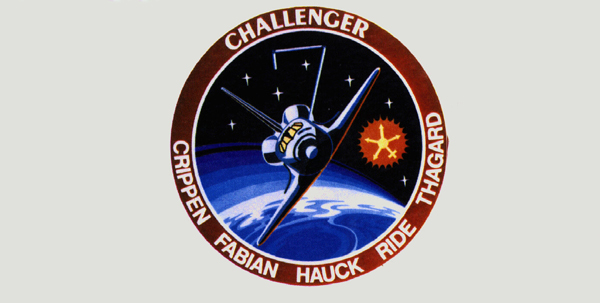
STS-7
Mission: Communications Satellite Launch/First U.S. Woman in Space
Space Shuttle: Challenger
Launch Pad: 39A
Launched: June 18, 1983 at 7:33:00 a.m. EDT
Landing Site: Edwards Air Force Base, Calif.
Landing: June 24, 1983 at 6:56:59 a.m. PDT
Mission Duration: 6 days, 2 hours, 23 minutes and 59 seconds
Orbit Altitude: 160-170 nautical miles
Orbit Inclination: 28.5 degrees
Sally Ride became the first American woman to fly in space. Two communications satellites were deployed, ANIK C-2 for TELESAT Canada and PALAPA-B1 for Indonesia, both were attached to the Payload Assist Module-D (PAM-D) motors. Seven Get Away Special canisters in the cargo bay held a variety of experiments, including one studying affects of space on social behavior of an ant colony in zero gravity. Ten experiments were mounted on the Shuttle Pallet Satellite (SPAS-01) and performed research in forming metal alloys in microgravity and the use of a remote sensing scanner. The orbiter's small control rockets were fired while SPAS-01 was held by the remote manipulator system to test the movement on an extended arm. Experiment 1: To investigate space sickness was carried out. Other payloads on this mission were: Office of Space and Terrestrial Applications-2 (OSTA-2); Continuous Flow Electrophoresis System (CFES); Monodisperse Latex Reactor (MLR) and one Shuttle Student Involvement (SSIP) experiment.
Crew consisted of Commander Robert L. Crippen, Pilot Frederick H. Hauck and Mission Specialists John M. Fabian, Sally K. Ride and Norman E. Thagard.
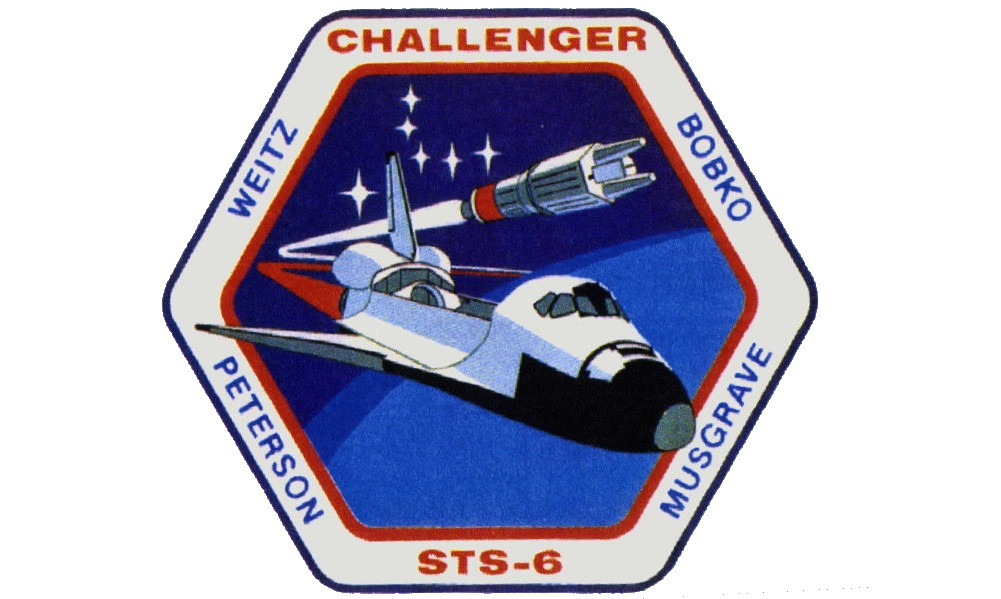
STS-6
Mission: Tracking and Data Relay Satellite-1 (TDRS-1)/First Shuttle Space Walk
Space Shuttle: Challenger
Launch Pad: 39A
Launched: April 4, 1983 at 1:30:00 p.m. EST
Landing Site: Edwards Air Force Base, Calif.
Landing: April 9, 1983 at 10:53:42 a.m. PST
Mission Duration: 5 days, 0 hours, 23 minutes and 42 seconds
Orbit Altitude: 184 nautical miles
Orbit Inclination: 28.5 degrees
The primary payload was the first Tracking and Data Relay Satellite-1(TDRS-1). A malfunction of the Inertial Upper Stage booster resulted in placement of the spacecraft into an improper but stable orbit. Additional propellant aboard the satellite was used over next several months to gradually place TDRS-1 into its properly circularized orbit. The first space walk of the Shuttle program performed by Astronauts Peterson and Musgrave, lasted about 4 hours and 17 minutes. Other payloads on this flight were: Continuous Flow Electrophoresis System (CFES), Monodisperse Latex Reactor (MLR), Radiation Monitoring Experiment (RME). Night/Day Optical Survey of Lightning (NOSL), and three Get Away Special canisters. This Mission used the first lightweight external tank and lightweight rocket booster casings.
Crew consisted of Commander Paul J. Weitz, Pilot Karol J. Bobko and Mission Specialists Donald H. Peterson and F. Story Musgrave.
1982
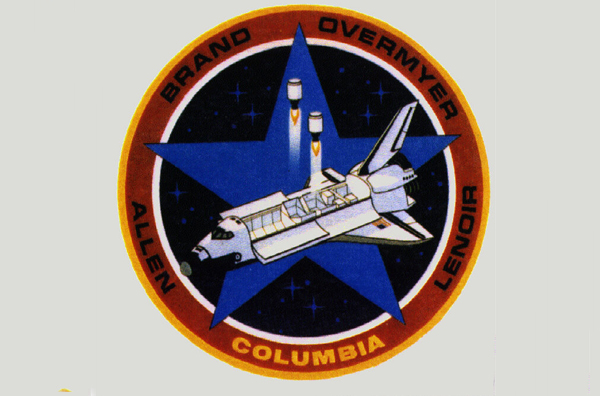
STS-5
Mission: Commercial Communications Satellites (ANIK C-3)/Satellite Business Systems (SBS-C)
Space Shuttle: Columbia
Launch Pad: 39A
Launched: Nov. 11, 1982 at 7:19:00 a.m. EST
Landing Site: Edwards Air Force Base, Calif.
Landing: Nov. 16, 1982 at 6:33:26 a.m. PST
Mission Duration: 5 days, 2 hours, 14 minutes and 26 seconds
Orbit Altitude: 184 nautical miles
Orbit Inclination: 28.5 degrees
This first shuttle operational mission deployed two commercial communications satellites, ANIK C-3 for TELESAT Canada and SitS-C for Satellite Business Systems. Each satellite was equipped with a Payload Assist Module-D (PAM-D) solid rocket motor, which fired about 45 minutes after deployment, placing each satellite into a highly elliptical orbit. One Get Away Special and three Shuttle Student Involvement Program (SSIP) experiments were conducted. The first scheduled space walk of the shuttle program was canceled due to a malfunction of the space suit.
Crew consisted of Commander Vance D. Brand, Pilot Robert F. Overmyer and Mission Specialists Joseph P. Allen and William B. Lenoir.
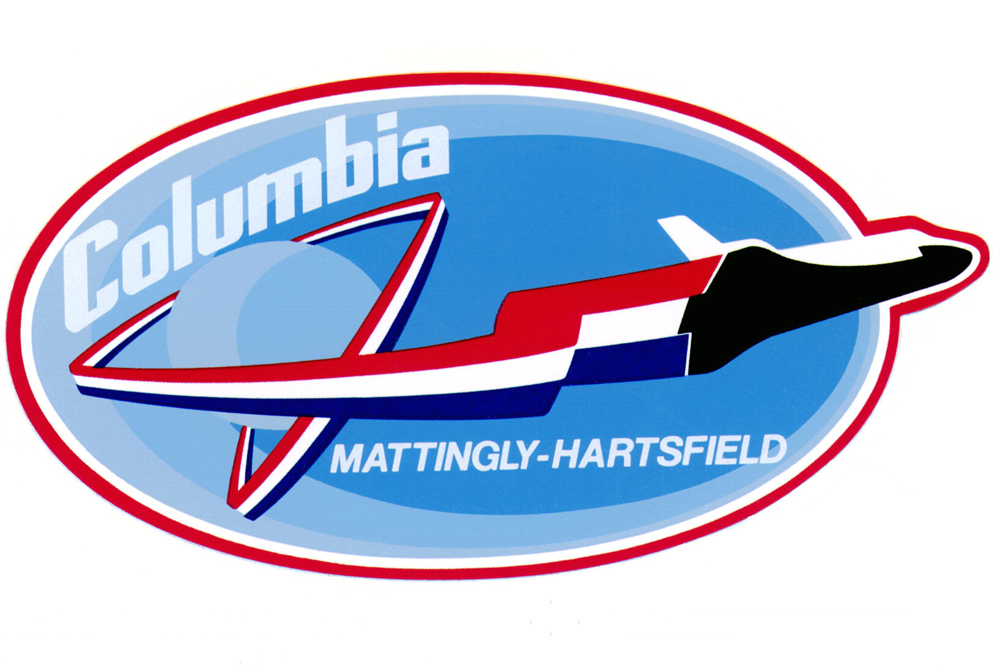
STS-4
Mission: Department of Defense/Continuous Flow Electrophoresis System (CFES)
Space Shuttle: Columbia
Launch Pad: 39A
Launched: June 27, 1982 at 11:00:00 a.m. EDT
Landing Site: Edwards Air Force Base, Calif.
Landing: July 4, 1982 at 9:09:31 a.m. PDT
Mission Duration: 7 days, 1 hour, 9 minutes and 31 seconds
Orbit Altitude: 197 nautical miles
Orbit Inclination: 28.5 degrees
The Final Space Transportation System research and development flight. In addition to classified Department of Defense payload, cargo included first Get Away Specials, (G-001) which contained nine experiments from Utah State University; first commercial experiment involving Continuous Flow Electrophoresis System (CFES); Monodisperse Latex Reactor (MLR); Induced Environment Contamination Monitor (IECM), which was deployed, and two Shuttle Student Involvement Program (SSIP) experiments. Crew performed medical experiments on themselves for two student projects, operated remote manipulator arm to swing IECM around orbiter, and took photos of lightning activity in Earth's atmosphere. Two solid rocket booster casings were lost when main parachutes failed and they impacted the water and sank. Some rainwater penetrated protective coating of several tiles while orbiter on pad. On orbit, affected area turned toward sun and water vaporized, preventing further tile damage from freezing water.
Crew consisted of Commander Thomas K. Mattingly II and Pilot Henry W. Hartsfield, Jr.
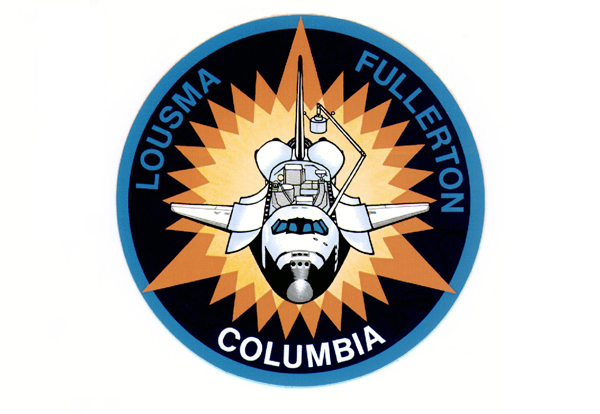
STS-3
Mission: Third Shuttle Mission/Office of Space Science-1 (OSS-1)
Space Shuttle: Columbia
Launch Pad: 39A
Launched: March 22, 1982 at 11:00:00 a.m. EST
Landing Site: White Sands, New Mexico
Landing: March 30, 1982 at 9:04:46 a.m. MST
Mission Duration: 8 days, 0 hours, 4 minutes and 46 seconds
Orbit Altitude: 147 nautical miles
Orbit Inclination: 38.0 degrees
Testing continued of space shuttle systems for qualification for operational flights. Testing of remote manipulator system and measurements of thermal response of orbiter in various attitudes to sun conducted. Get Away Special test canister and Spacelab pallet-mounted experiments for NASA's Office of Space Science-1 (OSS-1) carried in payload bay. OSS-1 obtained data on near-Earth space environment, including contamination (gases, dust, etc.) introduced into space by orbiter itself. Other experiments: Monodisperse Latex Reactor (MLR), Electrophoresis Equipment Verification Test (EEVT), Heflex Bioengineering Test (HBT) and first Shuttle Student Involvement Program (SSIP) experiment. Problems encountered: space sickness, malfunctioning toilet, thermostat difficulty and unexplained static interfering with crew sleep. Auxiliary power unit registered overheating during ascent, but functioned properly during descent. Three communications links were lost.
Crew consisted of Commander Jack R. Lousma and Pilot C. Gordon Fullerton.
1981
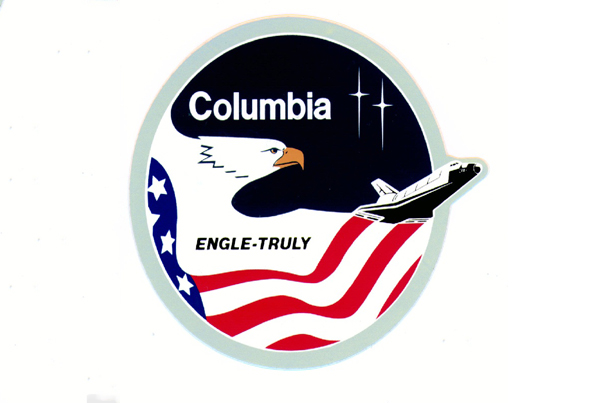
STS-2
Mission: Second Shuttle Mission/Office of Space and Terrestrial Applications-1 (OSTA-1)
Space Shuttle: Columbia
Launch Pad: 39A
Launched: Nov. 12, 1981 at 10:09:59 a.m. ESTLaunch Weight: 320,708 pounds
Landing Site: Edwards Air Force Base, Calif.
Landing: Nov. 14, 1981 at 1:23:11 p.m. PST
Mission Duration: 2 days, 6 hours, 13 minutes and 12 seconds
Orbit Altitude: 157 nautical miles
Orbit Inclination: 38.0 degrees
The planned five-day mission was cut nearly three days due to failure of one of three fuel cells that produce electricity and drinking water, but 90 percent of mission objectives achieved, including first time remote manipulator system tests. Mission scientists were satisfied with data received from Office of Space and Terrestrial Applications-1 (OSTA-1) Earth observation experiments mounted on Spacelab pallet in payload bay.
Crew consisted of Commander Joe H. Engle and Pilot Richard H. Truly.

STS-1
Mission: First Shuttle Mission/Shuttle Systems Test Flight
Space Shuttle: Columbia
Launch Pad: 39A
Launched: April 12, 1981 at 7:00:03 a.m. EST
Landing Site: Edwards Air Force Base, Calif.
Landing: April 14, 1981 at 10:20:57 a.m. PST
Mission Duration: 2 days, 6 hours, 20 minutes, and 53 seconds
Orbit Altitude: 166 nautical miles
Orbit Inclination: 40.3 degrees
Major systems tested successfully on first flight of Space Transportation System. Orbiter sustained tile damage on launch and from overpressure wave created by the solid rocket boosters. Subsequent modifications to the water sound suppression system eliminated the problem. A total of sixteen tiles were lost and 148 tiles were damaged.
Crew consisted of Commander John W. Young and Pilot Robert L. Crippen.
Join our Space Forums to keep talking space on the latest missions, night sky and more! And if you have a news tip, correction or comment, let us know at: community@space.com.

Space.com is the premier source of space exploration, innovation and astronomy news, chronicling (and celebrating) humanity's ongoing expansion across the final frontier. Originally founded in 1999, Space.com is, and always has been, the passion of writers and editors who are space fans and also trained journalists. Our current news team consists of Editor-in-Chief Tariq Malik; Editor Hanneke Weitering, Senior Space Writer Mike Wall; Senior Writer Meghan Bartels; Senior Writer Chelsea Gohd, Senior Writer Tereza Pultarova and Staff Writer Alexander Cox, focusing on e-commerce. Senior Producer Steve Spaleta oversees our space videos, with Diana Whitcroft as our Social Media Editor.









